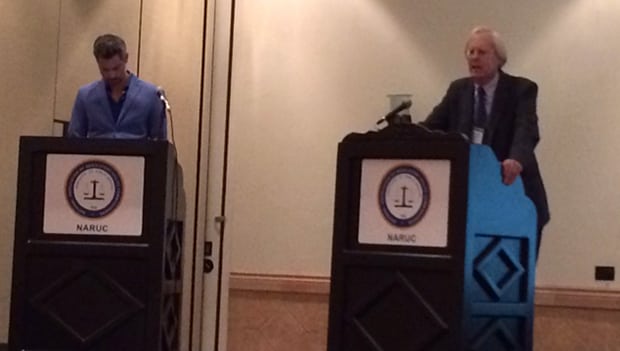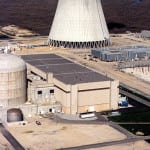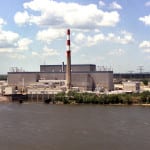RESOLVED: Retaining nuclear capacity is necessary to secure a reliable, cost-effective, low-emissions supply of electric power in the United States. That was the proposition for a debate between two high-profile opponents in “A Square-Off on Nuclear Policy” on November 16, the last day of the National Association of Regulatory Commissioners (NARUC) annual meeting in La Quinta, Calif.
In reality, the Oxford-style debate pitted two brands of environmentalists against each other. Ralph Cavanagh, Natural Resources Defense Council (NRDC) co-director energy policy, and Michael Shellenberger, president of Environmental Progress and cofounder and senior fellow at the Breakthrough Institute, faced off with NARUC President Travis Kavulla as moderator. Cavanagh, whose group has been a strong advocate of renewables, especially wind and solar plus energy efficiency, played the role of the nuclear opponent, while Shellenberger took the position in favor of the proposition.

Ultimately, the debate added little to anyone’s understanding of the issues but did serve as a clever way to keep at least some attendees on site for the last morning of the event.
The debate, clearly staged to entertain more than to persuade (the vast majority of session attendees were supportive of nuclear power and of supporting existing capacity with subsidies, should they be needed) drew upon Shellenberger’s actual positions while Cavanagh, rather than arguing whole-heartedly against nuclear, slipped into a more nuanced statement of his and the NRDC’s actual views more than once. His bottom line was that decisions about whether existing nuclear plants should be offered public support when markets render them uneconomic should be made on a case-by-case basis. As example, he noted that he was in favor of the seven-year lease extension to keep the Diablo Canyon Nuclear Power Plant online until sufficient replacement clean energy could be added.
Cavanagh, who presented his position first, began by saying that the public has been rejecting nuclear power for years and that nuclear shouldn’t be declared a winner in advance because there are other clean power options, including wind, solar, and energy efficiency.
Shellenberger’s opening statement was supplemented by a large number of slides that went by faster than attendees could appreciate them for their actual value, but the intended message overall was that solar power in particular is far less significant in meeting the demand for low-carbon power than nuclear power, yet subsidies for wind and solar outweigh those for nuclear.
Though strong claims for opposing positions are to be expected in a debate, there were some rather unusual ad hominem attacks and outright inaccuracies. Suffice it to say that Cavanagh took exception to being lumped in with some of the more colorful and extreme anti-nuclear voices from the 1970s and with Shellenberger’s claim that the NRDC “is in charge of California energy policy.” Then there was the bizarre claim that “all” the desert tortoises moved during construction of the Ivanpah concentrating solar power plant subsequently died. (POWER can find no evidence of anything approaching that claim. Associate Editor Thomas Overton, who covered the Ivanpah project when it first went online, said that some tortoises may have died, “but my understanding was the main risk was from predation of juvenile tortoises by ravens and coyotes. The U.S. Fish and Wildlife Service reports didn’t mention a lot of deaths—just the risks of them. Brightsource told me their biologists had saved a bunch of juveniles that would not have survived.”)
But Shellenberger (who noted that he had previously lobbied [changed from “was a lobbyist” at Shellenberger’s request Nov. 17] for the solar industry) also honed in on the weaknesses of the position Cavanagh was taking for non-nuclear resources to fill the gap left by nuclear plant closures. When Cavanagh said that energy storage could make variable renewables as valuable as nuclear, Shellenberger pushed him on how many minutes of energy storage the state of California currently has. First, Cavanagh made the case for the large amounts of storage state utilities have recently contracted for, but after he said he didn’t know how many minutes the currently installed storage capacity represented, Shellenberger said there were 23 minutes of backup storage in the state today.
Nuclear at All Costs?
Issues of nuclear safety, the need for maintaining aging nuclear plants, and nuclear waste were all part of the debate. Some of the more political issues, particularly Shellenberger’s claim that Governor Jerry Brown’s energy advisor has pressured utilities to close all nuclear plants, were not rebutted, in part due to the debate format. But some safety issues did come up again in the audience Q&A period. Even Kavulla, the otherwise affable host for the debate, commented that he found Shellenberger’s dismissal of concerns about onsite storage of spent nuclear fuel to be “flippant.”
To the original debate topic, Cavanagh argued in the Q&A that his opponent wants nuclear “at all costs,” whereas “cost matters.” That aspect of today’s no-stakes debate is becoming a matter of high stakes in Illinois.
Nuclear Cost Debate Gets Real in Illinois
Yesterday, legislation dubbed “Exelon’s energy bill” by Crain’s Chicago Business finally took a step forward in Illinois. The primary effect of the measure would be to throw a lifeline to two Exelon nuclear plants, Clinton and Quad Cities, which the utility has said will shut down absent subsidies from the state and its ratepayers. The two plants have lost a combined $800 million in the past seven years, according to Exelon.
However, the final version of the Illinois energy bill introduced on November 15 also includes support for coal plants, a demand charge, and the elimination of net metering, all of which have garnered opposition. Environmental groups, including the NRDC, previously in favor of supporting the nuclear plants, have withdrawn support for the bill now that coal plant subsidies are part of the package, several sources reported.
Should the support package pass, it would save jobs at the two nuclear plants but raise rates for electricity customers. In fact, Midwest Energy News reported that “Abe Scarr, director of the public interest group Illinois PIRG, described the bill, particularly the rate design changes, as an ‘end-run’ around the Illinois Commerce Commission, which would normally decide such issues after taking expert testimony and doing copious studies.” That this legislative development happened while those very state regulators were at the NARUC meeting underscores the unusual measures currently being taken in current power markets.
A vote on the Illinois legislation is expected the week after Thanksgiving.
—Gail Reitenbach, PhD, editor (@GailReit, @POWERmagazine)









